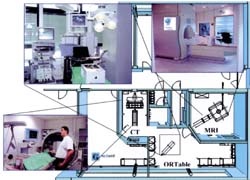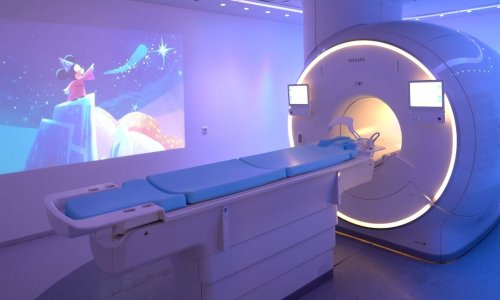Operating theatres: the future
Professor Andreas Melzer MD, University of Applied Sciences, Gelsenkirchen, Germany, describes the world's first experimental Operating Room System for Intervention, Tomography and EndoSurgery (OT SITES)
Innovative Technologies are the driving force behind the development of medical procedures aimed at minimum invasiveness with the highest precision and best clinical results.

Advanced technologies in the Operating Theatre, such as imaging systems, robotics, computer assistance, navigation and monitoring, involve significant effort and a very high level of training and education. Because an appropriate technological qualification is not always present, severe technical mishaps and malfunction may occur, which increase the risk for a patient as well as time loss.
Generally, neither technical training facilities nor specific technology study courses are provided for medical and technical staff. Apart from the utmost safety of surgical technologies, the goals of the future operating theatre are efficacy and efficiency, which can be achieved by optimising environments with systems-oriented integration of devices, instruments and ancillary equipment. Additionally, process analysis/management, and workflow control are essential for optimum co-ordination of procedural stages and personnel, and to enable the best surgical planning and economic allocation of resources.
Such a complex operating system needs a specialised, dedicated qualification profile - a ‘clinical engineer’, who should have a broad technology background and appropriate competence in the basics of clinical applications, along with practical experience in minimally invasive procedures.
OT SITES
After five years of planning, the first experimental Operating Room System for Intervention, Tomography and EndoSurgery (OT SITES), for the integration of imaging technologies, was installed at the University of Applied Sciences Gelsenkirchen in June 2002.
Industrial sponsors include: Innomedic, AutoSuture, Ethicon, ComputerMotion, G-Tec, Kaldunski&Lˆhr; Innomedic, Imedco, Philips, Olympus Winter&Ibe, Neuromed, TecMedic, Simag, Trumpf und Richard Wolf. Finance has also been provided from unversity and public grants. OT SITES is dedicated to research and development (R&D) as well as projects and education (student and postgraduate courses).
Students from the Department of Physical Engineering can focus either on micro-technologies (MEMS) or health technologies.
Laparoscopic surgery, arthroscopy, neurosurgery etc. can be virtually simulated and the imaging modalities of computed tomography (CT) and magnetic resonance imaging (MRI) can be implemented. Thus, MI technologies are being further developed and the current use and ergonomics of medical devices and ancillary systems can be analysed.
Waldemar Zylka and his team improved CT navigation, based on the Philips TomoGuide system. TecMedic, Gelsenkirchen, is developing video optic registration and navigation. Active resonant implants, such as stents and vena cava filters, including catheter and delivery systems with active MRI markers, have been realised and pre-clinically tested.
MRI compatible robotics are currently being developed in a project with Innomedic, Herxheim and FZK Karlsruhe, and pre-clinical evaluation will be performed in the MRI unit. Inter-disciplinary projects are conducted in co-operation with other departments. Medical technologies are reviewed from both technical and economic perspectives - including DRG reimbursement options.
The Incubator Centre, FH Gelsenkirchen, is supporting start-ups.
This close relationship with industry carries outstanding potential for commercialisation of developments and the OT educational platform.
Contact: a.melzer@pt.fh-gelsenkirchen.de. Team: Waldemar Zylka, Brigitte Kipfmueller, Udo Jorczyk, Gelsenkirchen
30.04.2003











